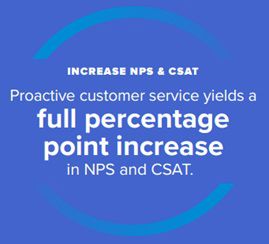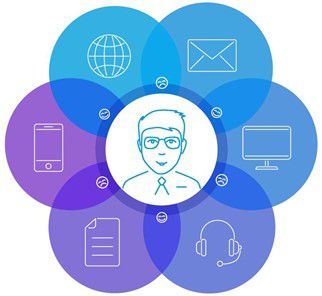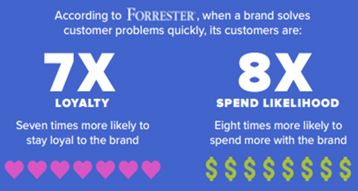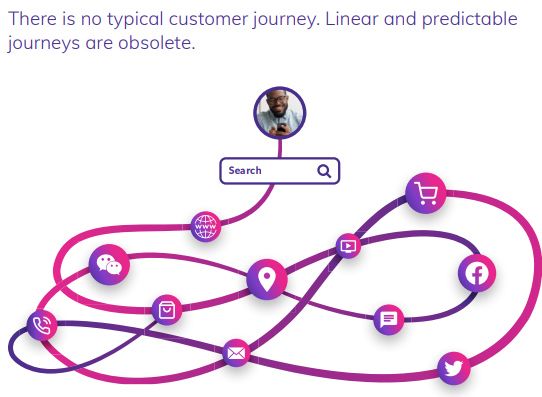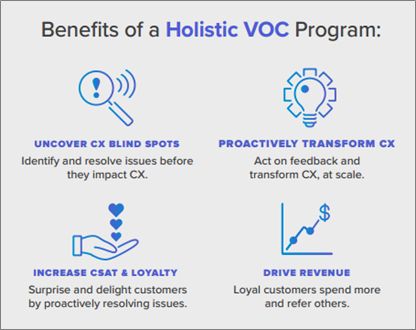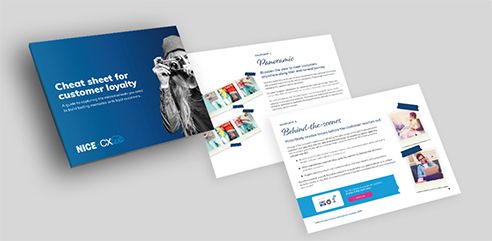The customer experience is like an elephant
There’s a parable about an elephant that’s been passed down and retold across cultures and throughout centuries, from ancient Eastern religious texts to 19th century American poetry to modern-day children’s books. There are slight variations to the story, but it basically goes like this:
A group of six blind men who have never seen an elephant before hear that a strange animal has been brought to town. They decide that they must inspect it with their hands to figure out what an elephant looks like.
The first man reaches out and places his hands on the trunk, feels around, and says, "This animal is like a big snake!”
The second man reaches all the way up to the elephant’s ear, feels it, and says, “This animal is nearly flat, like a kind of fan.”
The third man, whose hand lands on the elephant’s leg, says, “This animal is a pillar, like a tree trunk.”
The fourth man, who has placed his hands on the elephant’s side, says, “I don’t think this is an animal at all, it is a wall.”
The fifth man grabs the tail and says, “This animal is like a rope.” Finally, the sixth man reaches up, feels the elephant’s cool tusk, and says, “This animal is smooth and like a spear.”
You can see how each man was right and wrong at the same time because he was only focusing on one small part of the elephant at a time.
The same can be said for trying to evaluate and improve the customer experience. Focusing on merely part of an interaction’s full picture does nothing to solve or answer the issue in its entirety.
A holistic view of customer feedback is vital
If you only listen to customer feedback at a particular point in the customer journey, or after a specific type of contact center or digital touchpoint interaction, or via a single survey or via a single channel, or if you analyze specific operational metrics in isolation… you’re missing a true, complete picture of the elephant.
Your understanding of customer experience (CX) will be skewed and incomplete without a holistic view of customer needs and behaviors that includes direct, indirect, and operational feedback throughout the customer journey. Voice of the Customer (VOC) insights are invaluable in helping to reveal evolving customer expectations, and subsequently address them in a timely and effective manner before they impact loyalty.
Such holistic CX data reflects what your customers say, think, and feel across the comprehensive experience, and, when operationalized in the contact center, can actually shift an agent’s interactions from reactive to proactive. And that really pays off.
According to Gartner, “Proactive customer service results in a full percentage point increase in the net promoter score, customer satisfaction score, customer effort score, and value enhancement score.”[i]
When armed with customer feedback, your contact center agents are better equipped to move at the customer’s speed, to build trust in all the micromoments that matter most, and most importantly: to create the kind of strong connections that drive long-term loyalty.
The cumulative effect of micromoments
Whether it’s paying a bill, checking account details, scheduling a service call, updating a password, making an in-person visit, or exploring your website for upgrade options, each micro-moment—as well as your customers’ memory of each interaction—all add up to shape their experience with your organization, and how loyal they are to your brand. At every touchpoint, your organization has the opportunity to either build trust and loyalty or erode Net Promoter ScoreⓇ (NPSⓇ) and Customer Satisfaction (CSAT). This may run the risk of creating churn or even losing a customer forever.
Below are the micromoments that matter most, and how a holistic VOC approach can help you better understand and positively impact CX in real-time to create lasting relationships.
Identify where the customer journey really begins
It’s easier to capture VOC and CSAT data on customers who reach out to the contact center for help. But according to Harvard Business Review, 81% of customers attempt to take care of matters themselves before reaching out for agent-assisted customer support.[ii]
Traditional CX initiatives typically provide a narrow view of the end-to-end journey, so most contact centers aren’t considering or managing the customer journey at its real start. A holistic VOC approach captures these formerly hidden interactions to help provide a more accurate view of the journey’s complete context.
To meet customers where they are in the moment, a best practice is to bring the answers they seek into their preferred channels. Optimize your website and customer content for quick and effortless self-service, and always make it easy for customers to reach a live agent if needed.
Solve the self-service disconnect
With all the recent emphasis on digital transformation, as well as research showing that most customers prefer self-service,[iii] it may be surprising to see how many companies still fail to empower their customers to resolve issues themselves.
According to Gartner, while 70% of customers use self-service channels, only 9% are able to complete their resolution journey through that self-service.[iv]
In the NICE CXone: 2020 Customer Experience (CX) Transformation Benchmark, an overwhelming 90% of customers said that chatbots and virtual agents need to get smarter.[v] That same benchmark found that half of all customers who begin in a self-service channel transfer to a live agent.
Artificial intelligence is the key to scaling smarter, faster, and more successful self-service. By leveraging AI-powered self-service, you can:
- Provide 24/7 availability via voice or messaging
- Start where customer journeys truly begin: in their original web search
- Resolve simple, routine customer needs and easily navigate more complex conversations
- Improve self-service applications using automated insights from all human conversations
Eliminate digital friction to drive customer loyalty
Today, customers of all ages have embraced digital—it’s no longer just Gen Z and Millennials. So, meeting customers where they are in their particular journey means enabling them to navigate that journey on their preferred channels, capturing and taking action on the VOC wherever they are.
With widespread adoption, there are higher expectations for digital experiences. To get it right and build trust, look for specific moments that remove friction from certain journey touchpoints and capture satisfaction:
- Integrate channels into a unified framework to ensure continuity and a consistent experience across digital and physical channels
- Guide the customer toward the quickest path to resolution; for instance, seamlessly deflecting from interactive voice response (IVR) to SMS or messaging options
- Make every conversation personal and efficient by routing each interaction to the best agent across any channel
- Empower customers to take immediate action in digital channels by incorporating rich media, like secure forms, payments, and scheduling
- Point customers toward their preferred digital channels, e.g., display options like SMS, Apple Business Chat, or Facebook Messenger on your website or web chat
Proactively resolve issues to increase loyalty and spend
Moving at the customer’s speed means delivering the right answer at the right time: before the customer even asks. And, with the right tools and technology, it’s quite possible to deliver satisfying micromoments proactively.
What does proactive outreach look like?
- Pinpoint when, what, and how to resolve customer needs using search results or other customer triggers
- When channels have long wait times, guide the customer to channels that offer more immediate assistance
- Suggest relevant products and content based on customer interests and buying history
And for the agent-assisted interactions that remain, a proactive approach means providing contact center agents the tools and technology they need at their fingertips to personalize their customer interactions, increase first contact resolution (FCR), and reduce hand-offs.
You can accomplish proactive customer service, at scale, using predictive and purpose-built AI. It’s the easiest way to remove customer effort across every micromoment.
Why does this matter? According to Forrester, when brands solve customer problems quickly, their customers are 7 times more loyal and 8 times more likely to spend more with the brand.[vi]
Eliminate CX blind spots throughout the customer journey
No matter how we try to map them, customer journeys aren’t linear. They’re made up of multiple touchpoints that span physical and digital; they ping-pong between stages, and slide back and forth across devices.
This circuitous route can lead to CX blind spots. The technology used to shape experiences directly affects your contact center’s ability to orchestrate seamless journeys. It also impacts how effectively you capture VOC data at every point along the way.
Beyond creating a vendor management headache, the presence of multiple siloed CX solutions in your tech stack can result in conflicting or overlapping services and a disjointed experience for both agents and customers. Instead, focus on investing in a smart, secure, unified experience technology capable of capturing VOC throughout the customer journey, and evolving to meet your changing business and customer needs.
Customer interactions shouldn’t be a rough patchwork of handoffs between agents and channels. With fully integrated technology, you overcome CX blind spots by capturing all customer journey interactions and data in one interface. That way, you can quickly identify and overcome moments of friction that impact CSAT and loyalty.
The importance of listening through your customers’ eyes
To complete the story of the influence and impact of a customer’s experience, it’s critical to gather a complete understanding of the entire experience landscape. This means connecting all types of feedback together, including surveys. The only way to truly understand why a customer feels the way they do is to ask them. It really is that simple.
Direct, solicited feedback provides four key contributions to understand and act on the actual voice of the customer. As a vital source in understanding the complete customer experience landscape, direct customer feedback uniquely contributes to the understanding of:
- The customers’ feelings and perceptions based on the experience
- The context or situation in how the customer interprets the experience
- The organization’s focus on being customer-centric by listening and acting on customer input
- Any priorities and opportunities for improvement
How real-time feedback impacts loyalty
Some of the best opportunities for customer listening are completely in the moment, capturing raw, honest, real-life human emotion—a voice inflection, a shared laugh, and even the occasional muttered expletive. No matter how digital or automated the customer journey becomes, the human connection is still important.
Even when you adopt smart automation and AI to manage routine interactions across the customer journey, your agents still need soft skills, such as critical thinking, empathy, active listening, and rapport building. Agents might need them even more since the contact center is increasingly the “last resort” for unsuccessful self-service customers.
But traditional soft skills coaching takes time supervisors don’t have, performing tasks like crawling through hours of recordings for behavior examples and after-the-fact performance analysis, when CSAT has already taken a hit and a customer may have churned. With instant, in-the-moment coaching, you can catch, correct, and positively reinforce agent behaviors in the vital micromoments that most impact the customer interaction outcome, because agents are an extension of your brand.
According to research by Aberdeen, real-time interaction guidance results in a 3.3x annual increase in customer retention.[vii] When speaking with an agent whom they deem helpful and sincere, the positive experience stays with them; it builds trust, and they associate that positive, personal interaction with your brand.
How indirect & operational insights drive experience innovation
Despite best intentions, there’s often a disconnect between the CX that businesses believe they are delivering and customers’ actual perceptions.
To get an accurate picture of how customers perceive your experience and where you need to reduce friction, it’s best to go directly to the source. But it’s also vital to listen to the qualitative and quantitative feedback that customers aren’t submitting in a survey. Here are a few examples of such feedback:
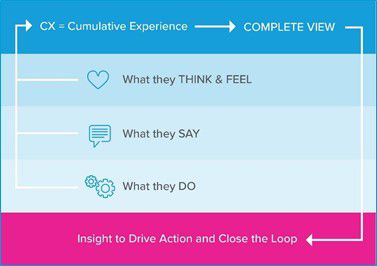
- Sentiment in their voice and the words they use during interactions
- Time, number of channels, and attempts it takes to resolve a need
- Volume bottlenecks and abandons in IVR as well as other channels
- Number of agents they speak to and times they must repeat information or re-authenticate
It is really the consideration of all available the sources that contextualizes experiences and enables a complete understanding of the customer journey.
An AI-driven experience solution analyzes these indirect and operational metrics—along with direct feedback in real-time—to identify CX improvement opportunities and deliver insights that will help you eliminate friction throughout the customer journey.
The benefits of operationalizing holistic VOC data
When you operationalize holistic VOC insights, your contact center becomes the center for CX transformation, and you no longer need to wonder if you’re only touching one part of the elephant and missing the big picture.
- You can effectively empower customers to complete a self-service journey if it is their preferred method.
- Your contact center team can proactively identify and resolve issues before they impact CX.
- Agents become more confident and happier in their jobs, which increases retention because they’re equipped to deliver brand-affinity building excellence in all the micromoments that matter most.
- FCR is improved when the context is added from the entire customer journey, resulting in higher CSAT, NPS, and loyalty
- Revenue increases as loyal customers increase their spending and are more likely to refer others.
Transform every micro-moment into picture-perfect loyalty
To help you move at the speed of your customers, we’ve assembled a Cheat Sheet for Customer Loyalty, which acts as an album that captures the most important snapshots to take to impact customer experience—the micromoments that add up to lasting relationships.
[i]Gartner: How Proactive Customer Service Will Transform Customer Experience (2020)
[ii] Harvard Business Review: Kick-Ass Customer Service (2017)
[iii] Salesforce: State of the Connected Customer (2020)
[iv] Gartner: Does Your Digital Service Strategy Deliver? (2019)
[v] NICE CXone: 2020 Customer Experience (CX) Transformation Benchmark (2020)
[vi] Forrester: The CX Professional’s Guide to Working with Contact Center Technologies and Leaders (2021)
[vii] Aberdeen: The ROI of Real-Time Agent Guidance: How AI helps align agent performance with customer expectations (2021)





